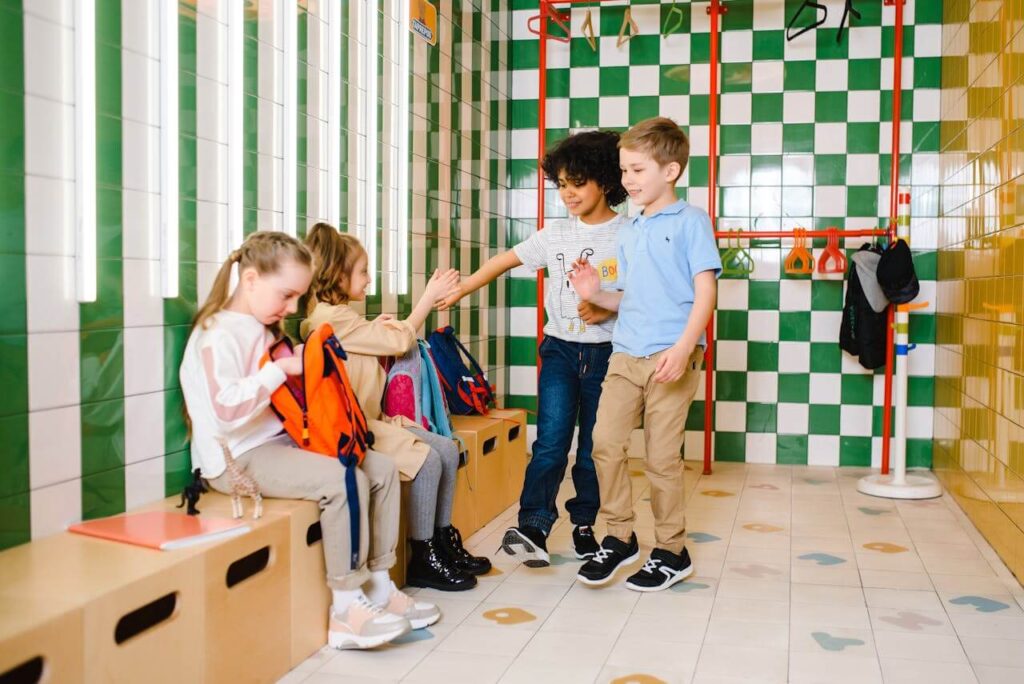Introduction
The first day of school is a moment etched in every parent’s heart—your child, just 4 to 6 years old, stands at the threshold of kindergarten or preschool, their tiny backpack slung over their shoulders, eyes wide with a cocktail of excitement, curiosity, and maybe a hint of fear. As a parent, you feel it too: pride swelling in your chest, a lump in your throat, and a quiet worry about how they’ll fare in this new world of classrooms, teachers, and friends. This milestone isn’t just a day on the calendar; it’s the start of your child’s educational journey, and you want to give them the tools to step forward with confidence, calm, and joy.
Navigating your child’s first school day requires more than packing a lunchbox or buying pencils—it’s about preparing their heart and mind, supporting their emotions, and fostering resilience for the days ahead. This ultimate guide, crafted for parents like you, covers every aspect of parenting through this transition: from building excitement before the big day to nurturing emotional well-being afterward, and ensuring long-term success in their school adventure. Packed with heartfelt stories, expert insights, practical strategies, and parent-tested product recommendations, this article will inspire you to guide your child into school with love and confidence. Let’s make their first day a stepping stone to a lifetime of learning.
Why the First School Day Matters
The first day of school is a pivotal moment for young children, marking their entry into a structured environment with new rules, relationships, and expectations. For kids aged 4–6, this transition can spark a range of emotions—excitement about new friends, anxiety about separation, or overwhelm from unfamiliar routines. How parents handle this moment can shape their child’s attitude toward school for years to come. A 2024 study in Child Development found that children who are well-prepared and emotionally supported during school transitions show lower stress levels, higher engagement, and better social skills, laying a foundation for academic and personal success.
Consider Emma, a mom from Denver with a five-year-old daughter, Lily. “Lily was thrilled about kindergarten but panicked about leaving me,” Emma shared. “We practiced routines and talked about what school would be like, and it turned her fear into excitement. She walked into class smiling, and I knew we’d done something right.” Emma’s story underscores the power of intentional parenting during this milestone, helping kids embrace school with courage.
Why Parenting Matters Here
- Emotional Security: Preparation and support reduce anxiety, helping kids feel safe.
- Confidence Building: Practicing skills fosters independence and pride.
- Lifelong Impact: A positive first day sets a joyful tone for learning.
The Three Pillars of First School Day Success
Supporting your child through their first school day rests on three key pillars: preparation (getting them ready before the day), emotional support (helping them process the experience during and after), and long-term thriving (ensuring sustained success in school). Each pillar involves specific strategies to address your child’s emotional, practical, and social needs, creating a holistic approach to parenting through this transition.
Pillar 1: Preparing Your Child for the First Day
Preparation is the foundation of a smooth first school day. By starting early, you can build excitement, familiarize your child with routines, and equip them with skills to feel capable. This proactive approach reduces fear of the unknown and empowers your child to step into school with confidence.
Strategies for Preparation
- Build Excitement with a Countdown
Create a visual countdown calendar 2–3 weeks before school to spark anticipation. Let your child decorate it with stickers daily, turning preparation into a game. The Melissa & Doug Countdown to Christmas Calendar is versatile, with reusable stickers kids adore. My friend Rachel used it to count down to her son’s preschool start, and it became a daily joy. Check it out here—it’s a fun way to ease nerves. - Practice School Routines
Mimic school mornings a week ahead—waking up, dressing, eating breakfast, and packing a bag. Use a kid-friendly backpack like the Skip Hop Zoo Backpack, lightweight with playful designs that kids love. See it here—it’s perfect for little ones. Practice skills like zipping a jacket or opening a lunchbox to build independence. - Read Books About School
Storytime can demystify school, showing it as a fun, welcoming place. Books like The Kissing Hand by Audrey Penn address separation anxiety with heartwarming tales. My neighbor’s daughter clung to it before kindergarten. Take a look here—it’s a must-read for first days. Read nightly to spark excitement and comfort. - Role-Play School Scenarios
Set up a pretend classroom at home with stuffed animals as “classmates.” Practice activities like raising hands, sharing, or lining up to build social skills. The Melissa & Doug School Time Classroom Play Set makes role-play engaging and educational. Check it out here—it’s a confidence builder for kids. - Talk About School Expectations
Discuss what school will be like—teachers, friends, and activities—in simple, positive terms. Use a journal like the Big Life Journal for Kids to draw or write about school hopes and fears. My sister’s son loves it for expressing himself. See it here—it’s a tool for emotional growth. Encourage questions to ease worries.
Case Study: Liam’s Kindergarten Prep
Mark, a dad from Chicago, faced challenges preparing his shy four-year-old son, Liam, for preschool. “Liam was nervous about new people,” Mark said. They started a countdown calendar, practiced dressing independently, and read First Day Jitters by Julie Danneberg. Check it out here—it’s a school-day gem. “By the first day, Liam was eager to meet his teacher. It felt like a miracle,” Mark shared. Liam’s story shows how preparation turns anxiety into enthusiasm.
Pillar 2: Providing Emotional Support During and After the First Day
The first school day is an emotional rollercoaster—your child may be buzzing with stories or quiet from overload. Emotional support during and after this day helps them process feelings, recharge, and feel loved, ensuring they return to school with enthusiasm. This pillar focuses on creating a safe space for expression and connection.
Strategies for Emotional Support
- Ease Drop-Off Anxiety
Keep goodbyes brief and cheerful to prevent prolonged distress, per Zero to Three advice. Pack a comfort item in their backpack, like a Schleich Animal Figurine, small enough to hold discreetly. My friend’s daughter carried one to preschool for comfort. See it here—it’s a tiny security blanket. - Create a Calming After-School Routine
Establish a predictable routine with a snack, rest, or quiet play to help your child unwind. Use a snack container like Munchkin Snack Catcher to keep messes low and snacks fun. Take a look here—it’s a parent lifesaver. Aim for 15–30 minutes of calm to transition from school to home. - Listen Actively and Ask Open-Ended Questions
Encourage your child to share their day with questions like “What was the funniest thing that happened?” or “Who did you play with?” A Conversation Starter Cards for Kids set sparks meaningful chats. Check it out here—it’s a bonding tool. Listen without pushing to build trust. - Encourage Creative Expression
Drawing, storytelling, or play helps kids process emotions. A sketchbook like Crayola Ultimate Light Board lets them draw their school day, opening up stories. My neighbor’s son loves it after school. See it here—it’s a creative outlet. Set up an art corner for post-school reflection. - Celebrate Their Efforts
Praise specific achievements, like sharing with a friend, to boost confidence. Use a “star chart” with Melissa & Doug Reward Stickers to track successes. Check it out here—it’s a motivation booster. Celebrate with hugs or a treat to make them feel proud.
Case Study: Sophie’s After-School Sanctuary
Sarah, a mom from Phoenix, noticed her five-year-old daughter Sophie was exhausted after her first kindergarten day. “She was quiet and snappy,” Sarah said. They created an after-school routine with snacks in a Bentgo Kids Lunch Box and coloring with Crayola Washable Crayons. See the lunchbox here and crayons here—they’re kid favorites. “Sophie started sharing stories about her day, and it brought us closer,” Sarah said. Sophie’s routine helped her thrive emotionally.
Pillar 3: Ensuring Long-Term School Success
The first school day is just the beginning—your child’s early school experience shapes their love for learning and social growth. Long-term success involves maintaining routines, fostering independence, and addressing challenges to keep your child engaged and confident throughout the school year.
Strategies for Long-Term Success
- Maintain Consistent Routines
Stick to predictable sleep, meal, and homework schedules to stabilize your child’s school life, per American Academy of Pediatrics guidelines. Use a Simple Houseware Closet Organizer to prep clothes and supplies nightly, saving morning stress. Check it out here—it’s a time-saver. - Foster Independence
Encourage skills like opening snack containers or tying shoes to build self-reliance. A Step2 Playhouse at home provides a space to practice “grown-up” tasks through play. See it here—it’s a joy spark for independence. - Stay Connected with Teachers
Build a relationship with your child’s teacher to monitor progress and address concerns. Keep notes in a Mead Primary Journal to track updates or questions. Take a look here—it’s a parent organizer. Regular check-ins ensure tailored support. - Encourage Social Skills
Help your child navigate friendships by practicing sharing or taking turns at home. A board game like Peaceable Kingdom Cooperative Game fosters teamwork. Check it out here—it’s a social skill builder. Arrange playdates to reinforce connections. - Monitor Emotional Health
Watch for signs of stress (e.g., withdrawal, tantrums) and offer extra support. A Big Joe Classic Bean Bag Chair creates a cozy nook for heart-to-heart talks. See it here—it’s a relaxation haven. Consult a counselor if challenges persist.
Case Study: Ethan’s School Year Triumph
Mike, a dad from Seattle, saw his four-year-old son Ethan struggle with preschool fatigue. “Ethan was cranky after school and didn’t want to go back,” Mike said. They set up consistent routines, used a Wildkin Kids Lunch Box for fun meals, and played cooperative games to build social skills. Check the lunchbox here—it’s a kid hit. “Ethan loves school now and has a best friend. I’m so proud,” Mike shared. Ethan’s journey shows how sustained support fuels success.
Practical Tips for Holistic Parenting
- Visit the School Early: Tour the classroom or playground before school starts to familiarize your child with the space.
- Plan a First-Day Celebration: Mark the milestone with a special dinner or activity, using a Crayola Creativity Tub for post-school crafts. See it here—it’s a creative celebration.
- Balance Activities: Limit extracurriculars the first month to avoid overwhelm, focusing on rest and play.
- Stay Positive: Frame school as an adventure, even if challenges arise, to maintain enthusiasm.
- Self-Care for Parents: Take time for yourself with a journal like The Five Minute Journal to manage your emotions. Check it out here—it’s a parent’s reset.
Overcoming Common First School Day Challenges
- Separation Anxiety
Practice short separations at home and pack comfort items like a Aurora World Teddy Bear. See it here—it’s a cuddly confidant. Reassure your child you’ll be back, keeping drop-offs quick. - After-School Meltdowns
Offer a snack and quiet time to reset emotions. A Munchkin Snack Catcher makes snacks easy. Take a look here—it’s a meltdown preventer. Avoid overloading with questions right after school. - Reluctance to Share
Use creative activities like drawing to coax stories, giving your child space to open up naturally. A Crayola Washable Markers set is great for expression. Check it out here—it’s a storytelling tool. - Morning Chaos
Prep clothes, lunches, and bags the night before to streamline mornings. A Simple Houseware Closet Organizer keeps everything in place. See it here—it’s a morning hero. - Social Struggles
Role-play friendship scenarios at home and encourage small gestures like smiling at classmates. A Peaceable Kingdom Cooperative Game builds social confidence. Check it out here—it’s a friendship starter.
Tips for Sustained School Success
- Regular Check-Ins: Chat daily about school to keep communication open, using open-ended questions to spark stories.
- Adjust Routines: Tweak schedules as needed to balance school, play, and rest, ensuring your child stays energized.
- Encourage Growth Mindset: Praise effort over results to foster resilience, per Mindset Works advice.
- Build Community: Connect with other parents at school events to create a support network, sharing tips and playdates.
- Monitor Progress: Track academic and social milestones with teachers, using a Mead Primary Journal for notes. See it here—it’s a progress tracker.
Why Invest in This Transition?
Your child’s first school day is a gateway to their future, and your role as a parent is pivotal. By preparing, supporting, and nurturing their growth, you’re not just easing one day—you’re building a foundation for confidence, curiosity, and joy in learning. With the right strategies and products, you’ll create memories of courage and connection that last a lifetime.
The Bigger Picture
- Emotional Resilience: Your support helps your child navigate challenges with strength.
- Academic Foundation: A positive start fosters a love for learning.
- Parent-Child Bond: Shared moments during this transition deepen your relationship.
Conclusion: Your Child’s School Adventure Begins
Your child’s first day of school is a milestone to cherish, and you’re their greatest ally in this journey. By preparing with excitement, supporting with love, and fostering long-term growth, you’re giving them the wings to soar through kindergarten or preschool and beyond. You’re not just a parent—you’re a guide, a cheerleader, and a safe haven for their biggest dreams. So, pack that backpack, share those stories, and watch your child shine in this new chapter.
Join the ParentMosaic community to share your first school day stories and tips. Let’s create a mosaic of confident, thriving kids, one classroom at a time!




